This short video on the home page of the Campaign for Safe Cosmetics is perfect for convincing your friends, family and coworkers that they should take an active interest in the content of their cosmetics and skincare products.

This short video on the home page of the Campaign for Safe Cosmetics is perfect for convincing your friends, family and coworkers that they should take an active interest in the content of their cosmetics and skincare products.
For those of you headed out on vacation, here are some important tips for child sun safety. An infant can burn in less than 10 minutes, even on a cloudy day. Aside from the obvious protection for your child (covering up, long sleeves/pants, hats, etc), be very selective about sunscreen. Here are some quick tips and my number one recommendation for baby sunblock:
1. Look for Zinc Oxide or Titanium Dioxide. These are physical sunscreens, rather than chemical sunscreens. Chemical sunscreens are absorbed into the skin to soak up the wave-lengths of sun so that they don’t penetrate deeper. The longterm effects of ingesting these chemicals is unknown but many chemical sunscreens contain known carcinogens. Another reason to use a physical as opposed to a chemical sunscreen is that babies and toddlers put their hands in their mouths all the time. Zinc oxide and titanium oxide are nontoxic, inert ingredients so they won’t react with any chemicals in the body to cause illness or an allergic reaction. Accordingly, you don’t have to worry about your child ingesting small amounts.
One note, titanium dioxide is somewhat controversial. It is a naturally occuring mineral that is chemically processed. Some studies indicated a slight increase in cancer levels in lab rats with long term exposure but others have concluded that the carcinogenicity of titanium dioxide is so low, it’s not classifiable as a human carcinogen. It is currently listed as non-toxic to humans and has no known adverse effects. This substance should be avoided in nano particle or ultrafine form, however. For more on Titanium Dioxide, read this article.
2. Look for Paraben-Free, PABA-Free, Fragrance Free sunscreen. The reasons should be obvious but in short, this will avoid a host of toxic, carcinogenic chemicals.
3. Get Broad Spectrum. It’s the only way to ensure your child is getting UVA and UVB protection.
4. Avoid Aerosol or Spray Sunscreen, Look for Non-Nano. Sunscreens are dangerous if inhaled or if they get in the eyes. Further, new consumer construct “ultra fine” and “nano” sized particles are absorbed at a more rapid rate by the body and penetrate deeper, thereby increasing the absorption of any toxic chemicals in your sunscreen. If you must use a spray sunblock (some is better than none!), spray it on your hand first, then apply to your baby (or yourself).
5. Check expiration date and monitor consistency and color. Avoid any expired sunscreen and throw out sunscreen that has changed color or consistency. This can affect efficacy and, in the case of chemical sunscreen, increase toxicity.
6. Apply properly and reapply every 2 hours or after swimming. Babycenter has a good video on how to apply sunscreen to your babe here, which should take about 5 minutes if done well. Don’t forget in between fingers and toes, behind ears and the neck and do the face last since it’s the most sensitive area for kids.
7. My sunscreen recommendation is Badger SPF 30+ Baby Sunscreen. It’s broad spectrum, non-nano zinc oxide with mostly certified organic ingredients.
If you’re driving this holiday season, check out Safe Mama’s Top Ten Eco-Friendly Toys for Entertaining Kids in the Car. This Bamboo work surface is great for coloring, books, puzzles, etc. and can double as a lap desk at home. 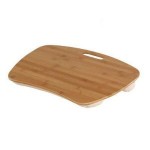
Another favorite that (hopefully) won’t end up in the cracks of your car seat are these Tengu magnetic blocks, which you’ll also find in my Registry section. 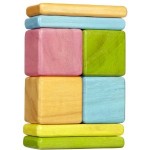
Of course, we have a ten week old so we’re better off with some sleep-inducing drug, aka Earth’s Best Organic Rice Cereal for Infants. I highly recommend Apple flavor mixed into breast milk or formula (check with the doc first).
Are we there yet?
Sodium benzoate is an ingredient that kept showing up on my Burt’s Bees product labels and other favorites that I had long considered ‘safe.’ I finally investigated. Sodium Benzoate is a commonly used food preservative as it’s quite good at killing bacteria and repelling fungi. It is produced by the neutralization of benzoic acid with sodium hydroxide and occurs naturally in low levels in foods such as prunes and apples. Sodium Benzoate is also used as a preservative in cosmetics and certain medicines.
There are reported health concerns about the combination of sodium benzoate and ascorbic acid or vitamin C, which frequently happens in sodas and vitamin C facial cleansers, for example. Sodium benzoate and potassium benzoate, when combined with vitamin C, form benzene, a known carcinogen. Despite the many drinks that contain both ingredients, apparently the benzene levels are below those considered dangerous for consumption. [1] That or the Grocery Manufacturers Association lobby got to someone at the FDA. Remember, the Surgeon General used to be a paid spokesperson for cigarette companies …
Also, keep in mind that factors such as light, heat, and expiration date can affect the rate at which benzene is formed.
Research out of the UK as recent as 2007 suggests that sodium benzoate, when combined with certain artificial colors, causes hyperactivity in children. Artificial colors are problematic in their own right as studies link them to cancer, allergies and hyperactivity, see Berry Toxic – artificial colors.
Though some claim that sodium benzoate isn’t harmful on its own, Professor Peter W. Piper of the University of Sheffield claims that sodium benzoate by itself can damage and inactivate vital parts of DNA in a cell’s mitochondria. This can lead to cell malfunction and programmed cell death.
In other words, Diet Coke is bad, mmmmmmm’k.
You might want to think twice before you give your kid mac and cheese for dinner again or buy her that berry-licious cereal. The FDA was recently considering a warning label for foods with artificial colors. That’s because studies show that artificial colors cause behavioral problems and have been linked to allergies in children and cancer (when tested on lab animals).
The report Food Dyes – A Rainbow of Risks reviews the known risks, as broken down by Fooducate:
Blue 1, Red 40, Yellow 5, and Yellow 6 have long been known to cause allergic reactions in some people. CSPI says that while those reactions are not common, they can be serious and provide reason enough to ban those dyes. Furthermore, numerous studies have demonstrated that dyes cause hyperactivity in children.
Tests on lab animals of Blue 1, Blue 2, Green 3, Red 40, Yellow 5, and Yellow 6 showed signs of causing cancer …
Yellow 5 also caused mutations, an indication of possible carcinogenicity, in six of 11 tests…
In addition, according to the report, FDA tests show that the three most-widely used dyes, Red 40, Yellow 5, and Yellow 6, are tainted with low levels of cancer-causing compounds, including benzidine and 4-aminobiphenyl in Yellow 5.
Europeans have demanded that these dyes be removed from products, yet the artificial coloring ingredients are still served up to the American consumer. For example, look at the difference in these two boxes of bars:
Why the double standard? In Europe manufacturers need to prove an ingredient is safe in order for it to be approved for use. In the U.S.A., it’s innocent until proven guilty. That is, U.S. scientists, researchers or consumers must prove that an ingredient is harmful before it will be banned. Do you really want to keep giving your kids Lucky Charms for 10 years and ‘wait and see’ if any of the ingredients cause cancer?
Katy Farber, Author of Non-Toxic Kids, recommends the following to avoid artificial colors:
*Read labels! Artificial food coloring HAS to be on the label. You’ll see it listed like this: “colored with (RED 40, YELLOW 5, BLUE 1)” as an example.
[n.b. if it says "artificial colors," just move on]
*Avoid regular food coloring in baked goods. Opt for natural versions instead available in the natural food section of your grocery store or your local natural foods store.
*Question brightly colored foods. They likely contain artificial food colorings (otherwise, how could they be so unnaturally bright?). Think rainbow colored popsicles, bright blue frosting, Jell-O, and Fruit Loops.
*Shop at your local natural food co-op, Whole Foods, or Trader Joe’s who refuse to sell any food that contains artificial coloring.
Easy.
Some smart lady just sent us these chunky Green Starts Little Vehicle Books. They are adorable and safer for your baby to chew on as they’re printed with soy-based ink and made from 98% post-consumer recycled materials (no bleach here). Thanks Elly!
Just a quick gift idea – we love these great organic and Oeko-Tex Standard certified baby and kids clothes by Hanna Andersson. The company did a great line for Serena and Lily at $36 each (currently on sale btw) but you can get the $24 version here.
 This is a perfect baby gift, reasonably priced, functional (easy zip on/off) and adorable!
This is a perfect baby gift, reasonably priced, functional (easy zip on/off) and adorable!
Since its founding in 2002, the Campaign for Safe Cosmetics has advocated the elimination of hazardous chemicals from personal care products.These products can legally contain ingredients linked to cancer, reproductive harm, learning disabilities and other serious health problems. Shockingly, the CSC points out that the Food and Drug Administration (FDA) has banned or restricted only 11 chemicals in cosmetics out of the more than 12,500 ingredients currently used. In contrast, the European Union has banned more than 1,100 chemicals from cosmetics.
We’ve clearly established that bath and other products labeled ‘safe,’ ‘gentle’ and/or ‘natural’ frequently are anything but. The Campaign for Safe Cosmetics conducted lab tests and found that many such products are contaminated with formaldehyde or 1,4-dioxane – and often times, both. These two chemicals, linked to cancer and skin allergies, are completely unregulated in children’s bath products.
The CSC highlights something that is shocking or even unbelievable to most people – that the Food and Drug Administration (FDA) oversees the safety of personal care products in the U.S., but lacks basic authority needed to either verify the safety of products or enforce existing regulations. ”The FDA cannot require companies to test products for safety before they are sold, does not systematically review the safety of ingredients and does not set limits for common, harmful contaminants in products.The FDA also does not require contaminants to be listed on product ingredient labels. As a result, consumers have no way of knowing if their products contain toxic contaminants.”
Read this important report, No More Toxic Tub HERE, the first to document the widespread contamination of children’s products with formaldehyde and 1,4-dioxane.
Remember, the terms “natural,” “herbal,” “gentle” or “safe” have NO LEGAL DEFINITION. This report charts the commonly used chemical names and phrases, such as “fragrance” used to describe what are toxic ingredients. More posts to follow in reference to this important resource. See also Baby’s Tub Is Still Toxic HERE.
More to come … holiday weekend + newborn = busy
Happy Monday campers. Similar to adults, babies like a little jingle. Especially the jingle jangle of your keys, which are probably filthy from rattling around the bottom of your purse or European man-satchel. Here is a great, nontoxic stainless steel teether and holiday gift idea for $24 made by Kleynimals (engraving available) – nice and shiny and new!
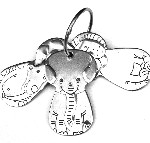
Since we’re on the topic, also check out Jingle Punks, where my brother-in-law composes amazing tunes. Jingle Punks creates little ditties for film, television, advertising or high end bachelorette parties. Ask for Will.
That reminds me of my favorite Alabama song, Dixieland Delight, which your baby will also love.
We painted our 4 week old’s feet blue the other day and made an awesome series of three prints for his nursery. Wish we had had this nontoxic Clementine Art Paint – check it out at this cool store My Little Green Shop, offering affordable eco-friendly stuff. The site also has nontoxic glue, crayons and other fun craft projects. 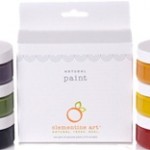
This Artterro Storybook Kit looks awesome. Not only is it made from wool, vegetable-based inks and recycled materials, but the company has also donated to Project Kids in Cambodia, an art program serving orphanages in Cambodia. This would make a great gift!
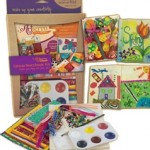
So order, muster and plan a fun, nontoxic afternoon for the kiddies. You know they’ll be sniffing the hard stuff at school.